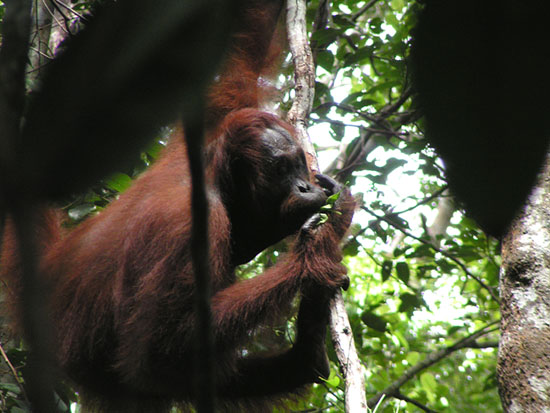Orangutans Make Musical Instrument

The evidence is mounting that culture isn't something unique to us humans: Orangutans in Borneo have developed and passed along a way to make a useful, improvised instrument, researchers report.
When in a tight situation, the orangutans will strip the leaves off a twig and make a crude musical instrument to alter the calls they use to ward off predators — not exactly a Stradivarius, but it seems to get the job done.
Several animals, particularly our primate cousins, have been found to use tools to aid in efforts such as foraging for food, a sign of culture, specifically the transmission of knowledge. This new finding marks the first time an animal has been known to use a tool to help it communicate, say the scientists who studied the behavior.
Kiss squeak
Wild Bornean orangutans (Pongo pygmaeus wurmbii) emit a particular call known as a kiss squeak — a sharp intake of air through pursed lips that makes a kissing sound.
Orangutans make this noise when they feel threatened, for example, when they fear a predator — such as a snake, clouded leopard, tiger or human — most likely to ward the predator off and not as a distress call. (Orangutans are somewhat solitary and it would take too long for the next nearest orangutan to respond.)
Kiss squeaks come in three different forms: unaided (lips only); with the hand in front of the lips; and with leaves in front of the lips. The leaves are stripped off a twig and held in a bundle in front of the orangutan's mouth while the animal makes the kiss squeak.
Sign up for the Live Science daily newsletter now
Get the world’s most fascinating discoveries delivered straight to your inbox.
When scientists first observed this behavior, they weren't sure exactly why the orangutans used the leaves. The new study suggests that the tool lowers the frequency of the kiss squeak, making the orangutan producing the call sound bigger to their potential predator.
Frequency and size
The bigger an orangutan is, the lower the frequency of its unaided kiss squeak, for physiological reasons, said study team member Madeleine Hardus of the University of Utrect in the Netherlands. So when smaller orangutans clasp their hand or a bunch of leaves to their mouth, they're likely doing it to artificially lower the frequency of their call and make themselves sound bigger.
Merely sounding bigger might do the trick to scare off a predator, because the jungles where the orangutans live are thick, which makes it difficult for the predator to actually see the primate and visually size them up.
The researchers recorded the leaf-altered kiss squeaks while they were observing orangutans who were not habituated to humans.
{{ video="LS_090805_orang-tool" title="Orangutans' Leafy Instrument" caption="An orangutan strips leaves from a twig and holds them to its mouth to produce the kiss squeak call." }}
Whether or not the improvised instruments actually ward off predators isn't known, "because it is extremely rare to experience an attack or to see a predator around orangutans," Hardus wrote in an e-mail to LiveScience.
Hardus and her colleagues think the aided kiss squeaks are evidence of culture in orangutans, because they are only seen in certain populations, versus unaided kiss squeaks, which are seen across populations.
The team's findings are detailed in the Aug. 5 online edition of the journal Proceedings of the Royal Society B.
With more observations, Hardus thinks this won't be the last evidence of culture in primates that scientists find.
"I am absolutely sure we will find other forms of culture in orangutans and other primates," Hardus said. "After decades of studying them, they keep on surprising us."
- Video – Orangutan's Leafy Instrument
- How Did Human Culture Evolve?
- Video – Clever Primates

Andrea Thompson is an associate editor at Scientific American, where she covers sustainability, energy and the environment. Prior to that, she was a senior writer covering climate science at Climate Central and a reporter and editor at Live Science, where she primarily covered Earth science and the environment. She holds a graduate degree in science health and environmental reporting from New York University, as well as a bachelor of science and and masters of science in atmospheric chemistry from the Georgia Institute of Technology.









